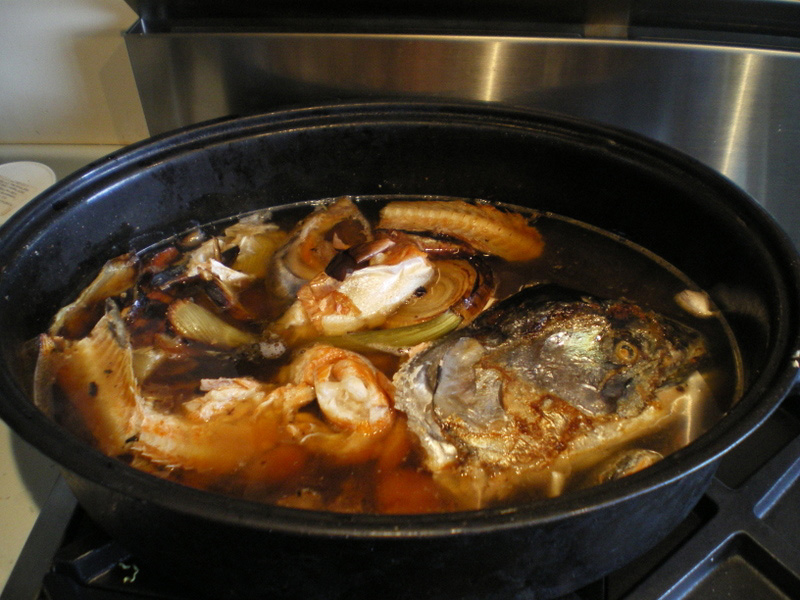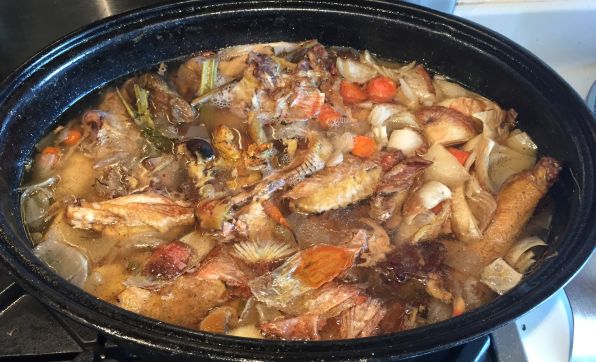 It occurs to me that along with a ruinous national debt, we’re leaving our children untold reams of blather that they’ll have to pick through to find any useful advice. So I’m going to post at least some practical information here. For example, how to eat very well and very cheaply, assuming you cook at all. The key is good stock. Stock is simple, it’s made from the cheapest meat and vegetable matter you can buy, and you can freeze it and add it to beans, rice, sauces, or make tasty soup or stew quickly.
It occurs to me that along with a ruinous national debt, we’re leaving our children untold reams of blather that they’ll have to pick through to find any useful advice. So I’m going to post at least some practical information here. For example, how to eat very well and very cheaply, assuming you cook at all. The key is good stock. Stock is simple, it’s made from the cheapest meat and vegetable matter you can buy, and you can freeze it and add it to beans, rice, sauces, or make tasty soup or stew quickly.
I’ve read a lot of recipes for stock, but you don’t need a recipe. You can make it from almost anything. Chicken stock is my favorite because it’s light and versatile—and Jewish penicillin, of course. If you don’t have a place where you can buy chicken feet or necks or other bony pieces, you can start with the bones of cooked chicken you’ve eaten (even from KFC) and maybe some wings or thighs. Take a couple of pounds of bones and meat and add enough water to cover them along with a tablespoon or two of vinegar. Bring to a simmer, and then lower to just below boiling. Cook for awhile—at least an hour, but more if you like. Then add vegetables. These can be trimmings—the skins and roots and stalks and greens of onions, carrots, celery—the parts you would throw away. You can (one of my favorite methods) just keep your pot on the back of the stove, and throw in the leavings from whatever vegetables you’re using, and bring it to the almost boil for at least 15 minutes a day over a few days time. Or if you’re in a hurry and want to make good stock fast, cut up and add a whole onion, a couple of carrots, some celery, whatever, leaves, peels, etc. Cook for at least an hour, but no upward limit really. You can ladle out some stock and strain it into whatever you’re making. For example, put a ladle full of stock into your rice water to add flavor. Or you can decide you’re done. Then strain the stock, and let it cook down to concentrate (without actually boiling). If it’s fatty, let it cool in the fridge overnight and peel off the top layer of fat. They heat it slightly, put it in ice cube trays, and freeze it. You have cubes of instant flavor.
There are now great covered ice cube trays with rubbery bottoms that make it easy to pop out a cube or two or twelve whenever you want to make sauce or stew or add flavor to anything on the stove. You can buy these from Amazon—is it still ok to buy from Amazon? they seem to own the world.
 If you like beef stock, do the same thing with beef bones; for fish, use heads and tails. You can make plain vegetable stock the same way, just no bones or vinegar. Corn cobs are a great addition to stock, the hearts of celery or cauliflower, carrot tops, onion skins. I’ve even thrown in avocado skins.
If you like beef stock, do the same thing with beef bones; for fish, use heads and tails. You can make plain vegetable stock the same way, just no bones or vinegar. Corn cobs are a great addition to stock, the hearts of celery or cauliflower, carrot tops, onion skins. I’ve even thrown in avocado skins.
If you like your stock rich and dark, roast whatever you’re starting with in the oven for about 45 minutes at 425 degrees first, so it slightly carmelizes before you start simmering (nice to add at least one whole onion). That’s what I did with the fish in this picture.
The only somewhat gross thing about stock is getting rid of the remains that you’ve strained out. These can get smelly if you don’t get them out of the house, especially if you’re using fish heads and tails. More about this when I show you my amazing compost blaster. But this is enough practicality for one day.
 I’d tried J. Kenji López-Alt’s method of chopping chicken into tiny bits, but it made a total charnal house of my kitchen, so I wanted to explore what else they suggested. Daniel Gritzner had a comprehensive article, and the comments about using a pressure cooker or bringing the stock to a boil then setting it in a 225 degree oven overnight interested me. I’m also going to try adding an apple with the onions, carrots, etc. The most interesting idea to me was to use one stock as a base to make another stock, layering and enriching the flavor. I’m definitely going to try that. Continue reading “Thinking about stock”
I’d tried J. Kenji López-Alt’s method of chopping chicken into tiny bits, but it made a total charnal house of my kitchen, so I wanted to explore what else they suggested. Daniel Gritzner had a comprehensive article, and the comments about using a pressure cooker or bringing the stock to a boil then setting it in a 225 degree oven overnight interested me. I’m also going to try adding an apple with the onions, carrots, etc. The most interesting idea to me was to use one stock as a base to make another stock, layering and enriching the flavor. I’m definitely going to try that. Continue reading “Thinking about stock” 

